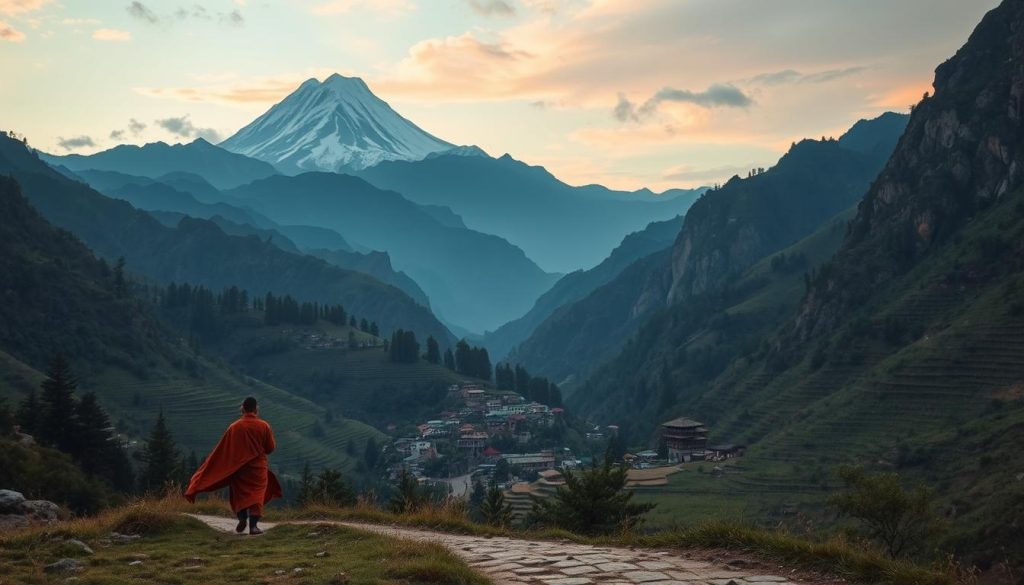Exploring scriptural geography shows a deep link between land and sacred stories. These stories have shaped our understanding for thousands of years. Religious texts are deeply connected to specific places, showing the close tie between history and ancient cultures.
Scholars know that geography is key to understanding religious texts. The landscape is more than just a setting; it plays a role in the stories. Places like the plains of Canaan and the valleys of Mesopotamia hold deep spiritual and cultural meanings.
By understanding these places, we gain deeper insights into the stories of old. The environment influenced the lives, travels, and spiritual paths of ancient people. This creates a rich story of human spiritual exploration.
Key Takeaways
- Geography is fundamental to understanding religious texts
- Landscapes provide context for sacred narratives
- Ancient civilizations developed complex relationships with their environments
- Religious texts reflect the geographic realities of their time
- Spatial context enhances interpretation of historical religious accounts
Introduction to Scriptural Geography
Scriptural geography is where history, theology, and geography meet. It looks at how landscapes affected ancient religious stories. Scholars study how land, people, and texts are connected.
This field is more than just making maps. It explores how geography shaped human experiences and beliefs. Mountains, rivers, deserts, and coasts were key in spiritual journeys and community life.
- Explores the connection between physical environments and religious narratives
- Analyzes geographic contexts of sacred texts
- Provides insights into ancient cultural developments
Key aspects of scriptural geography include:
- Spatial context of religious events
- Environmental influences on historical developments
- Mapping sacred locations and migration routes
Researchers use advanced tools like Geographic Information Systems (GIS). These tools help create detailed pictures of ancient landscapes. This gives us a better understanding of cultural heritage and historical events in sacred texts.
Understanding the Importance of Geography in Sacred Texts
Geography is key in religious stories, turning landscapes into powerful stories. Sacred texts are deeply connected to places, giving us deep insights into spiritual traditions.
Stories in religions often start with the land itself. This land shapes the lives of key figures and how we see ancient times. The environment is more than just a setting; it plays a role in the stories.
The Role of Land in Religious Narratives
Geographical features are central in sacred stories. Here are some key points:
- Terrain shapes spiritual journeys and challenges
- Landscapes symbolize theological concepts
- Natural boundaries define sacred spaces
Sacred Sites and Their Significance
Archeology shows us how certain places hold deep spiritual value. Mountain peaks, rivers, and desert regions are seen as places of divine connection.
Geographic Context of Key Events
Knowing the geography helps us understand religious experiences better. The land gives us context for scriptural stories, linking history with spirituality.
Understanding geography helps us dive deeper into religious texts. It shows how land influences human spiritual experiences across cultures.
Historical Overview of Sacred Geography
Sacred geography is where history, maps, and religion meet. Scholars study how understanding the land shapes our view of old stories and beliefs.
Looking into sacred geography shows how land, culture, and faith are linked. Researchers use many sources to learn about ancient geography. This helps us understand the past better.
Early Maps and Their Interpretations
Early map makers saw sacred lands with deep respect and creativity. Their work mixed:
- Theological views
- Little known geography
- Artistic flair
The Influence of Geography on Historical Context
Geography gives us key clues about religious stories. Spatial relationships in old maps help us understand historical and spiritual movements.
Evolution of Mapping Techniques
Mapping methods have changed a lot over time:
- Hand-drawn maps
- Printed maps
- Digital systems
New tech has changed how we study sacred geography. It lets us make more accurate pictures of ancient lands.
Major Religious Texts and Their Geographic References
Religious texts are more than just spiritual guides. They are detailed maps of sacred places, blending geography with spiritual stories. These texts have kept alive ancient memories and spiritual bonds with specific lands for thousands of years.
Sacred texts show deep links between geography and spiritual understanding. Each text offers a unique story of geography, going beyond simple place names.
The Biblical Landscape of Israel
The Bible paints a vivid picture of ancient Israel, highlighting key areas and their spiritual importance. It shares many aspects of sacred places:
- Mountains as sites of divine revelation
- Rivers marking historical boundaries
- Desert regions representing spiritual transformation
Quranic Geographic Perspectives
Islamic texts outline important historical and spiritual sites, linking places with deep religious experiences. The Quran’s references to geography shed light on the spiritual journey of early Muslims.
Vedic Sacred Geographical Narratives
Hindu sacred texts describe many sacred sites, turning physical locations into spiritual landmarks. The Vedas show how landscapes become filled with deep spiritual meaning, linking land and divine experience.
Analytical Approaches in Scriptural Geography
Technology and religious studies have changed how we see sacred texts. New methods give us deep insights into ancient places.
Experts have made tools to understand the space in old stories. These tools mix old theology with new tech.
Geographic Information Systems in Religious Research
Geographic Information Systems (GIS) are key for mapping holy places and old locations. Scholars can now:
- Reconstruct ancient landscapes
- Analyze spatial relationships in religious texts
- Visualize historical migration patterns
- Explore contextual environments of sacred narratives
Interdisciplinary Exploration of Sacred Spaces
Mixing geography and theology opens new ways to understand religious history. Spatial analysis helps researchers to:
- Contextualize biblical and historical accounts
- Understand cultural interactions
- Interpret symbolic geographical references
- Reveal deeper meanings in sacred texts
Textual Reference Mapping
Advanced spatial analysis lets scholars find geography in complex texts. By mapping these references, they understand how geography influenced ancient cultures and stories.
Geographic Regions and Their Theological Implications
Sacred landscapes have deeply influenced world events and cultural heritage across various religions. These areas are not just physical places. They hold spiritual value, linking believers to their core beliefs.

Religious texts show how certain areas go beyond their physical limits. They become symbols of divine connection and spiritual change. These places hold deep spiritual meaning, going beyond their physical features.
The Promised Land: A Biblical Perspective
The Promised Land is a key story in biblical traditions. It includes:
- Geographical boundaries set by divine covenant
- Symbolic of divine promise
- A spiritual home for Jewish culture
Sacred Cities of Islam
Mecca and Medina are vital in Islamic spiritual geography. These cities hold deep religious importance, acting as:
- Pilgrimage sites for millions of Muslims
- Historic centers of religious revelation
- Spiritual bases of Islamic identity
The Ganges: A River of Spiritual Significance
In Hinduism, the Ganges River is more than a river. It stands for spiritual cleansing, linking physical landscapes to spiritual experiences.
Cartography of the Ancient World
The art of mapping the world has always been linked to our understanding of geography, religion, and culture. Ancient cartographers turned geographical knowledge into visual art. These maps were more than just tools for navigation.
Important figures in history helped develop early mapping techniques. Archeology has uncovered how various civilizations saw their world through detailed maps.
Early Jewish and Christian Cartographic Traditions
Ancient Jewish and Christian mapmakers saw cartography as deeply spiritual. Their maps often put sacred cities like Jerusalem at the center. This showed their theological views of the world:
- Jerusalem as the spiritual epicenter
- Symbolic representations of religious territories
- Theological interpretations of geographic spaces
Islamic Contributions to Global Mapping
Islamic scholars made big strides in cartography during the medieval period. They created advanced mapping techniques that greatly expanded our understanding of the world:
- Advanced astronomical calculations
- Precise geographical measurements
- Comprehensive world atlases
Medieval Cosmological Representations
Medieval cartographers made detailed maps that mixed geography with spiritual ideas. Mappae mundi showed complex views of heaven and hell. These maps were deep theological statements about human life.
Cultural Impact of Sacred Geographies
Sacred geographies tell stories that go beyond just places. They link spiritual moments with cultural identities. These areas hold memories, spiritual changes, and social interactions that shape our views of the world.

Pilgrimages and Their Routes
Pilgrimage paths are key cultural links. They allow for spiritual discovery and meeting between cultures. These trips turn simple paths into deep spiritual journeys.
- Ancient pilgrimage routes connecting religious communities
- Spiritual transformation through geographic movement
- Cultural exchange facilitated by sacred travels
Economic Significance of Sacred Sites
Sacred places bring in a lot of money, drawing thousands each year. By looking at primary sources, we can see how these places boost local economies.
- Tourism revenue generation
- Local economic development
- Infrastructure investments
National Identity and Geographic Narratives
Geographic stories are vital in building national identities. They connect people through shared memories and spiritual landscapes. These bonds go beyond physical limits, creating deep cultural ties.
Sacred geographies show how spiritual, economic, and cultural aspects come together. They reveal the complex ways we connect with our surroundings.
Contemporary Perspectives on Scriptural Geography
Technology has changed how we study religious texts and places. Now, we can see sacred geography in new ways. Digital tools help us dive into religious landscapes like never before.
Today’s scholars use advanced tools to look at sacred areas and their pasts. Tools like Geographic Information Systems (GIS) and digital maps are key. They help us understand complex religious stories.
Modern Interpretations of Sacred Spaces
Now, scholars study sacred places in many ways. They mix theology with geography. Here are some main methods:
- Integrating archaeological evidence
- Using satellite imaging technologies
- Looking at how texts describe space
- Seeing how cultures change sacred areas
The Impact of Technology on Scriptural Mapping
Thanks to digital archives, researchers have more access than ever. They can build detailed pictures of ancient landscapes. This lets us see how places and stories are connected.
Case Studies of Contemporary Religious Geography
Recent studies show how tech sheds light on sacred places. Virtual reconstructions and interactive maps help us understand religious geography. They link the past to today’s views.
Technology and religious studies together give us new insights into sacred places. This helps us understand humanity’s spiritual paths better.
Conclusion: The Enduring Influence of Geography on Religion
Exploring scriptural geography shows a deep link between landscapes and spiritual stories. Throughout history, ancient cultures have shown how places shape religious beliefs and practices. Researchers find complex ties between land, migration, and sacred traditions.
New technology in mapping and spatial analysis has changed how we see religious texts. Tools like Geographic Information Systems (GIS) help scholars recreate ancient environments with great detail. These tools connect archaeological findings with text interpretations, giving us a clearer view of religious communities’ lives.
Future Directions in Scriptural Geography
New ways of studying sacred geographies are emerging. Scholars are using anthropology, archaeology, and technology together to understand how landscapes and beliefs interact. By looking at history through geography, we gain new insights into ancient cultures’ spiritual views of their surroundings.
Final Thoughts on the Intersection of Land and Faith
The study of geography and religion is always evolving. With better tools, researchers find more about how landscapes influence spiritual expressions. This ongoing study shows that geography is not just a backdrop for religious stories. It’s a key part that shapes and changes our spiritual views.